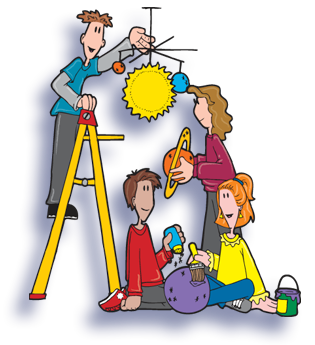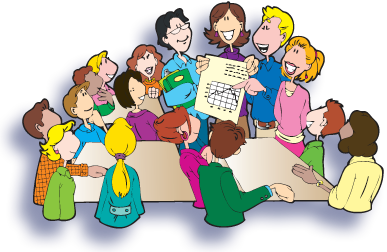Kagan's Articles - FREE Kagan Articles
Dr. Spencer Kagan
The “P” and “I” of PIES: Powerful Principles for Success
Special Article
II. Putting the "P" and "I" in Place
It is useful to distinguish three ways of creating positive interdependence: Resource Interdependence, Task Interdependence, and Reward Interdependence.
Resource Interdependence. By limiting the resources available to each student, we create interdependence. For example, if we give a group of students the task of creating a poster that has good integration of four colors, the high achiever might grab the colors and make the poster. Without proper structuring of teamwork tasks, we may fail to create interdependence. We can structure the task to create resource interdependence by simply assigning each student a different color with the rule that no one can touch anyone else's color. By creating this resource interdependence, the students cannot be successful unless each does his/her part. A contribution from each is necessary; no one can do the task alone. In that situation, students will feel they are on the same side and will cooperate.
 Task Interdependence. We can create positive interdependence by giving students a multi-faceted task to complete. For example, we can assign students a team presentation. To create interdependence we might structure the task so a contribution of each student is required. Alternatively, we might have each student present different parts of the presentation or assign each student a different role in the presentation. To create task interdependence, we give students a task that demands contributions from each. By creating task interdependence, student outcomes are positively correlated. The better the performance of each, the more positive the outcome for all. Because there is a positive correlation among their outcomes, students feel they are on the same side and it is very likely they will help and encourage each other.
Task Interdependence. We can create positive interdependence by giving students a multi-faceted task to complete. For example, we can assign students a team presentation. To create interdependence we might structure the task so a contribution of each student is required. Alternatively, we might have each student present different parts of the presentation or assign each student a different role in the presentation. To create task interdependence, we give students a task that demands contributions from each. By creating task interdependence, student outcomes are positively correlated. The better the performance of each, the more positive the outcome for all. Because there is a positive correlation among their outcomes, students feel they are on the same side and it is very likely they will help and encourage each other.
Reward Interdependence. We can create interdependence also by how we structure rewards. A common error made by teachers beginning cooperative learning is to give teams problems to solve and announce which teams scored the highest. This is negative reward interdependence. The better the performance of one team, the less likely the reward for another. A gain for one is a loss for another. In this situation, teams actually hope other teams do poorly and are very unlikely to encourage or help other teams. Here, there is positive interdependence within teams, but there is negative interdependence among teams. Students hope their teammates do well, but hope the other teams do poorly.
In contrast, we easily create positive reward interdependence by setting up a common goal to which all teams contribute. For example, the teacher might say, "If all teams score above 90, we will have five minutes of free time in class." In this situation, the gain of one team increases the probability of a reward for the other teams, and teams will encourage and help each other. The students feel they are on the same side with all their classmates. In this case, there is positive interdependence both within teams and among teams, creating a more cohesive community of learners.
I was once called in to consult with a school that wanted to motivate reading and reporting on books. In the prior year, they had set up a reward structure in which the class at each grade level that read and reported on the most books each month got an ice cream treat with the principal. Classes were in competition with each other and predictably, some classes did better than others. After a few months, classes that did not get a reward for a few months began to become unmotivated, saying We don't really care. I suggested they place a school thermometer in the cafeteria and every book that was read and reported on would contribute to elevating the thermometer. Rewards were place at set intervals, with an overnight read-in being the top reward. Students were interdependent, knowing no one student could reach the reward without the help of other students, so they encouraged each other to read and report. Far more books were read and reported on with the cooperative compared the competitive reward structure. Students felt they were on the same side, working toward a common goal. The contribution of each helped all. It was a cooperative rather than competitive reward structure.
With resource interdependence and task interdependence, we structure how students will work together; we structure their process. In contrast, with reward interdependence, we structure what will result from that work; we structure their outcomes.
III. Relationship to Each Other
How do positive interdependence and individual accountability relate to each other? The relationship between positive interdependence and individual accountability is a bit complex. Individual accountability does not necessarily create positive interdependence, but it can. Similarly, some types of positive interdependence create individual accountability; whereas others do not. Let's explore this further.
Individual Accountability Does Not Always Create Positive Interdependence.
Individual accountability can be created in many ways that do not create positive interdependence. We may have students take a test, write an essay, or contribute to their portfolio with no impact on the outcomes of others. In all of these cases an individual public performance is required, but in none of these cases does establishing individual accountability create positive interdependence.
Even a solo presentation for a performance evaluation, if the performance is for the teacher only, is a form of individual accountability without positive interdependence. If however, a student does a performance in front of the class, there is some positive interdependence: the better the performance, the more other students benefit (learn).
Individual Accountability Can Create Positive Interdependence.
There are ways, however, of creating individual accountability that create positive interdependence. The most common structure used worldwide is for a teacher to call on one student to answer a question posed by the teacher. This is a form of individual accountability: An individual public performance is required. This form of individual accountability also indirectly creates positive interdependence. Why? As the student answers, other students listen. If the student gives a correct answer, other students benefit by hearing the correct answer. This creates a positive correlation among outcomes—one student doing well helps other students.
It should be noted, however, that calling on one student to answer a question posed by the teacher involves negative interdependence as well. How? When the teacher asks the question, a number of students raise their hands in hopes of being called upon. The students are motivated to be called on, hoping for teacher and classmate attention and approval, a chance to validate their thinking, and a chance to be active. Let's say ten students are competing for the opportunity to respond. As the teacher calls on one, the other nine lower their hands and register their disappointment. They wanted something they did not get—to be called upon. The success of one resulted in the failure of the other nine to get the outcome they wanted. Their outcomes are negatively correlated. In situations like that, students do not hope for the success of their classmates. In fact, they're happy if the chosen student does not know the correct answer because it gives them a second opportunity to be the center of attention. In that case, the failure of a classmate actually increases the probability of a positive outcome for the others. Their outcomes are negatively correlated, a situation we call negative interdependence.
Many teachers give group projects. If students are graded individually on their component of the project, as in the Co-op Co-op4 design, there is individual accountability. Doing well on one's own component of the group project also helps the team succeed. Thus positive interdependence is created also by giving each student a unique and necessary component of the project. In a simple Timed Pair Share, each student in turn verbalizes his/her own thoughts to a partner for a predetermined time. Because each must perform in front of a partner, there is individual accountability. There is positive interdependence as well because if one partner has a good idea, that idea is communicated to the partner who then learns the idea. Notice, with Timed Pair Share, in contrast to calling on one student to answer, there is no negative interdependence. Every student has an equal opportunity to respond.

Positive Interdependence Often Creates Individual Accountability.
Many ways of creating positive interdependence also create individual accountability. For example, if we assign each student on a team a different color and instruct them to make a team poster, we have created positive interdependence and individual accountability: An individual public performance is required of each student and the better the performance of each, the better the performance of the group—their outcomes are positively correlated. Whenever group members are working toward a shared goal and can see the required performance of each individual, we have both positive interdependence and individual accountability.
Positive Interdependence Does Not Always Create Individual Accountability.
Not all ways of creating positive interdependence create individual accountability. For example, if we tell students to make a project, but do not hold each student individually accountability for her/his contribution, we have positive interdependence (the better each performs, the better for the others), but no individual accountability (individual performance is not required).
Pressure and Support.
Positive interdependence and individual accountability are two fundamental principles of cooperative learning. Understanding and applying those principles allows us to design successful cooperative learning and positive learning outcomes. Willingness to learn new and difficult content depends on a healthy combination of support and pressure. If we put a great deal of pressure on students and offer them too little support, they will become frustrated and may give up. (Picture a student struggling through a difficult worksheet with no one to turn to when they get stuck.) On the other hand if we give students a great deal of support but no pressure, they will have little motivation to learn. (Picture students told to learn a new skill, but that they will not be tested on the skill.) Optimal learning occurs with a healthy combination of pressure and support. Positive interdependence creates the support (teammates feeling on the same side, willing to encourage, tutor, help, cooperate). Individual accountability creates the pressure (knowing an individual performance will be required).
By understanding these two powerful principles and their relationship, we are better prepared to create optimal learning experiences for our students. We want both these powerful forces in effect as students learn. Kagan Structures—to which we now turn—are carefully designed to harness the power of these two principles.